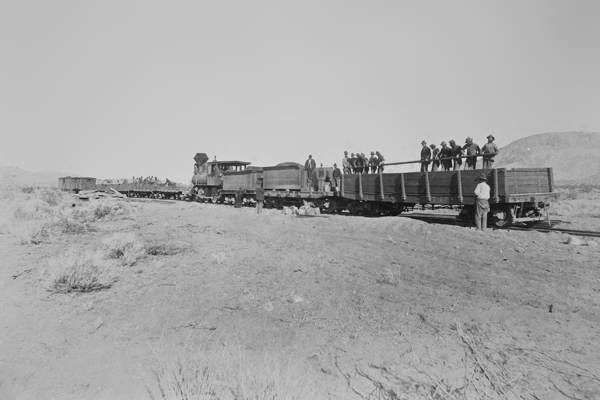Randsburg Railway
.jpg)
The Randsburg Railway was a 28.5-mile (45.9 km) branch-line railroad in California's Mojave Desert. It originated at Kramer Junction, California, and terminated at Johannesburg, California, with a stop at Atolia on the Atchison, Topeka, and Santa Fe Railroad (AT&SF).

Randsburg Railway December 1897.
A couple of miners in an attempt to extort money from the Randsburg Railway Company staked out a claim and proceeded to dig a shaft, causing an armed standoff with the track laying crew. The contractor laying the track withdrew and when the miners went home for the night the crew was brought back in and the shaft filled and the track laid over it effectively ending the dispute. - C.W. Tucker photosUpon its completion on January 5, 1898, the line began operation on January 17, 1898. AT&SF acquired the railway in 1903. Throughout its 35-year history, the Randsburg Railway served passengers and local mining operations.
As a result of the Great Depression and the decline in the mining industry, the Randsburg Railway ceased operations on December 30, 1933. A year later, the rails were removed. Portions of the grade are still visible along U.S. Route 395
The Randsburg Railway has a fascinating history closely tied to the mining boom in the Mojave Desert. Hereís a detailed look at its development and significance:
Early Development
The Randsburg Railway was established in the late 19th century during the gold rush era in the Mojave Desert. The discovery of gold in the Rand Mining District around 1895 sparked significant interest and led to the establishment of the towns of Randsburg, Johannesburg, and Atolia. The need to transport ore and supplies efficiently led to the creation of the Randsburg Railway.Construction and Operation
Inception:
The railway was chartered in 1897 and construction began shortly thereafter. It was completed and operational by 1898.Route:
The railway connected Johannesburg, where it linked with the Atchison, Topeka and Santa Fe Railway, to the mining towns of Randsburg and Atolia. The line covered a distance of approximately 30 miles.Purpose:
Primarily, the railway was used to transport ore from the mines to the mills and smelters. It also brought in essential supplies for the mining operations and the growing communities.Economic Impact
The Randsburg Railway was instrumental in the economic development of the Rand Mining District. It enabled the efficient movement of large quantities of ore, which would have been challenging and costly to transport by wagon. This transportation efficiency contributed to the profitability and expansion of mining operations in the area.Challenges and Decline
Fluctuating Fortunes:
The prosperity of the railway was closely tied to the success of the mining industry. As the mines produced less ore, the railway's revenue declined.Competition:
Improvements in road transportation and the advent of trucks offered more flexible and sometimes cheaper alternatives to rail transport.Closure:
By the 1930s, the diminishing returns from mining and the competition from road transport led to the decline of the railway. It eventually ceased operations.Legacy
Though the Randsburg Railway is no longer operational, its historical significance remains. It played a crucial role in the development of the Rand Mining District and the towns of Randsburg, Johannesburg, and Atolia. Today, the remnants of the railway serve as a reminder of the regionís rich mining history and the vital role of rail transport in supporting mining communities in the late 19th and early 20th centuries.This brief history highlights the importance of the Randsburg Railway in the context of the Mojave Desert's mining boom and its lasting legacy in the region.
Summary
The Randsburg Railway was established in 1897 to serve the gold-rich Rand Mining District in California, linking Johannesburg with the mining towns of Randsburg and Atolia. Completed by 1898, it facilitated the transport of ore and supplies, significantly contributing to the region's economic development. Despite its initial success, the railway faced challenges due to declining mining output and competition from road transport. By the 1930s, it ceased operations. The railway's legacy remains as a key player in the Mojave Desert's mining history and the development of local communities.
Randsburg
Kramer
Johannesburg
Atolia
Railroad Chronology
